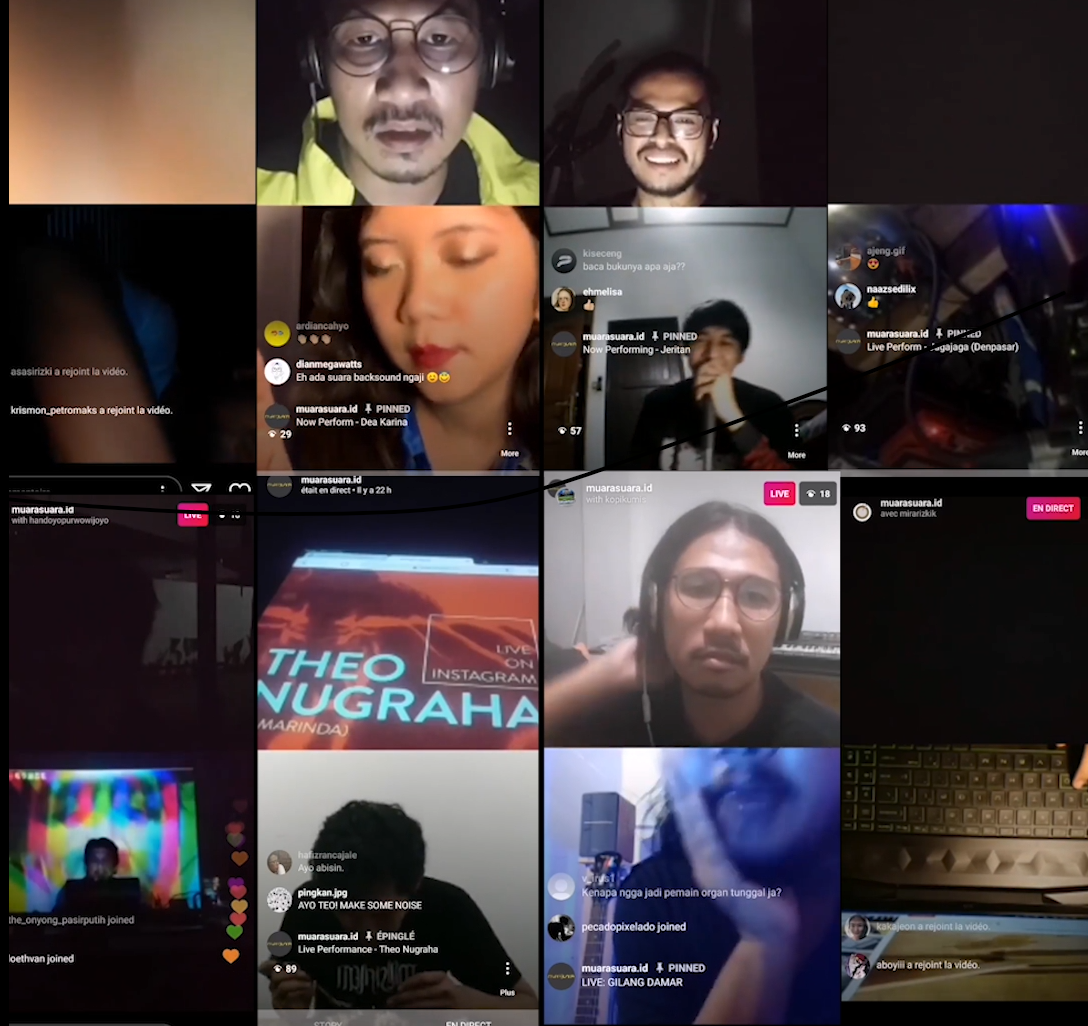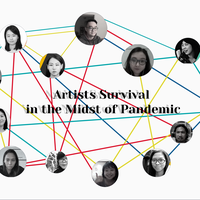Virtual360 Konnect | Dissecting Boundaries

Video capture of Leenalchi's performance for ONSTAGE, uploaded on the 온스테이지ONSTAGE Youtube Channel. Image courtesy of NAVER ONSTAGE(네이버 온스테이지)
During the Virtual360 Konnect – Emerging Arts Leaders Residency Series, Mi Seok HUH, a curator and researcher from Korea and Robby OCKTAVIAN, a sound artist from Indonesia, sought to dissect the online presentation of traditional art, music and sound. Combining their approaches, the pair looked into examples of how reinterpretations of traditional art has coped with the online landscape.

As art institutions and artists would have to rely more on the online due to COVID-19, it would be crucial to deliver exhibitions, programs, performances and artwork online effectively in a landscape already with a plethora of content in the age of internet platform creators and influencers. Though surviving that ocean of content may not be the main focus, programming that cultivates interest in different levels, and inspires to search and discover more—leading to more education, active experiments and collaborations through online networks—will create a diverse online landscape. To study this idea, reinterpretations and content on traditional music from both Indonesia and Korea were looked into. Points to think about on art presented online in the pandemic era were evolved from these observations.

Robby Ocktavian at Muarasuara Instagram Live. Source: Muarasuara
Founded in 2014, Balaan Tumann is a collective of musicians from the students and alumni of a music school in West Kalimantan. Taking from the seed culture of Malay and Dayak in West Kalimantan, it nonetheless has a broader insight and repertoire, giving ample scope to critiquing, renewing, and developing tradition. Balaan Tumaan draws the spirit from traditional art into forms and concepts that are relevant to the contemporary situation. They use devices commonly used by popular industries such as effects pedals, mixers, computers, and software, without having to get stuck with pop practices. One of the members and administrators, Nursalim Yadi Anugrah, is a composer and multi-instrumentalist from Pontianak, Indonesia. His interest in West Kalimantan cosmology, sonology, and culture is channeled into his unique approach to composition and instrumentation. Another member, Juan Arminandi, is a musician, composer, and instrument builder. Actively participating in various experimental music projects and research in musical traditions of Kalimantan, he created a new instrument which he called the MU74n (mutant), inspired by traditional Kalimantan instruments sape and selodang. Balaan Tumaan’s online presentation extends such reinterpretations of tradition, now taking the internet factor as part of the aesthetic. Unlike live performances on stage, digital sound presentation deals not only with the problems of the instruments and the sound they produce, but also with codecs and voices that are generated by digitisation, especially when it comes to online streaming. As such, the sound artists connect with other art media, such as the body, the screen, choreography, and lighting on stage.

Juan Arminadi describing his instrument. Source: Muarasuara

Juan Arminadi playing his instrument. Source: Muarasuara
Debuted in early 2019, Leenalchi is a band that mixes Pansori—a traditional Korean music storytelling performance—with alternative pop. In September 2019, they performed for an online-based platform ‘ONSTAGE’, which mainly presents indie music and also has a YouTube channel. Their performance was received positively and gained popularity. According to some comments, they were seen as the ‘real K-pop’. In July 2020, Leenalchi was cast in an advertisement campaign for “Imagine your Korea”, a tourism brand developed by the Korea Tourism Organization. Now they are more apparent in mainstream broadcasting outlets. It would be rash to conclude that Leenalchi became popular only because of their online presence, but it has helped for them to reach out to a larger audience and gain more attention. There are many contents that present not only reinterpretation, but also information on traditional music and practice. A YouTube creator, ‘DukcyDukcy Pungmul TV', has been uploading content on Pungmul—a Korean instrumental performance originated from agricultural ritual— since late 2018. This particular creator does Pungmul as a hobby, uploads interviews with performers, guides on how to play instruments, and performance sketches. He utilises the full potential of the creator platform, curating material and sharing with others.

Duckyducky pungmul TV Youtube Channel. Image courtesy of Seo Hyeon Deok, DuckyDucky Pungmul TV Channel owner and creator.
Does the presence of contents such as the above tow interest towards traditional music, and give more leeway for the relatively ‘unpopular’ genre to receive more attention than before? Just taking the case of Leenachi’s performance video, there were comments that shared information on Pansori, such as the translated lyrics and the context of the song. On the other hand, it could be said that one reason the band become explosively popular, aside from their amazing performance, was because they were considered hip in the sense that they are not entirely mainstream at the moment, reinterpreting the ‘old’ but at the same time aligned with what is popular in Korean culture today: retro, or ‘newtro’ vibes. It is hard to predict if this would trickle down to active appreciation, research, and experimentation that encompasses a wide range of people. However, all aspects of traditional sounds, experimental, conservative, can be thought of together.
Culture transforms, and only trying to stick to certain forms, or considering that only certain forms as canon and all others as mere aberration may actually limit access to the genre. Some traditional rituals and performances are in form of a spectacle to the public, and at times it is still considered taboo to experiment. Sometimes the sacred value of the art that limits it from changing forms becomes an obstacle in the exploration process of making it relevant to the contemporary period and not as mere exoticism. Artists who explore the potential of traditional arts to invite more people to experience work to connect traditional philosophy and spirit to our current situation and tastes, such as in the case of Balaan Tumaan and Leenalchi. The online then, is a ground where the pushback toward experimentation can soften and sources for reinterpretation can gather within a freer space. It is also a space where people can structure ways to appreciate culture, as can be seen in the individual YouTube creators’ content for Pungmul.
These observations give a glimpse on how traditional music transforms and reinterprets itself, and how some become popular. Culture and art itself have been open to various interpretations, and curation has become more common—it is now the way of life that anyone can do with any subject found within life. It may not be enough to mount edited material of exhibition tours, interviews, performances, etc. Then it is crucial to find what message a certain organisation or individual holds meaningful to their aspirations and identity in the field, and have this long term goal realised within the structure of online contents as well as within the content itself. At the same time, as seen in the reinterpretation projects of traditional music, conveying not just the meaning but also transformations of culture is important, as having a comprehensive view on what is taken as canon, the experimentation, and the trend altogether. Online platforms seem to have democratised the creation of culture, but creators and influencers have become a new power within another hierarchy and disparities in representation. As such, incorporating the exchange, cooperation, and interdisciplinary factor the online enables is crucial not only for cultural content and art presentation online, but also for the online landscape, now and after COVID-19.
This article is part of a series of articles written by the participants of Virtual360 Konnect - Emerging Arts Leaders Virtual Residency Series, an online cultural exchange and capacity building initiative developed by the Asia-Europe Foundation (ASEF) and the ASEAN Foundation through KONNECT ASEAN. Over a period of one month, 20 emerging art leaders from Korea and 5 countries of the ASEAN region (Brunei Darussalam, Indonesia, Malaysia, Myanmar, Philippines and Singapore) collaborated in pairs on the theme of international cultural exchange in the Covid-19 era.
Similar content
18 Oct 2020
posted on
03 Jul 2011
from - to
10 Sep 2022 - 11 Sep 2022
from - to
01 Oct 2016 - 06 Nov 2016






